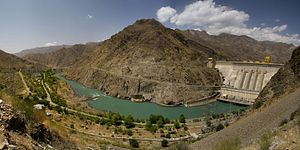If you followed the rhetoric, it would be easy to think that the Central Asia South Asia Electricity Transmission and Trade (CASA-1000) Project – set to export excess electricity from Tajikistan and Kyrgyzstan to markets in Afghanistan and Pakistan – is all but finalized. The project, after all, has not only received the go-ahead from regional governments, but has gotten backing from the U.S. State Department, the United Kingdom Department for International Development, and the World Bank.
Last week saw the latest round of back-slapping among officials involved. Per Sherali Saidamir Jononov, Tajikistan’s ambassador to Pakistan, Tajikistan and Pakistan took yet another step toward finalizing the inter-state electricity grid. As Jononov said, by 2018, Tajikistan will export some 1,000MW of excess electricity to Pakistan via a 750km transmission line. Further, as Dawn reported, “the said transmission line of 500KV would also be utilized for transmitting more than 300MW hydroelectricity to Pakistan from Kyrgyzstan.” And a Tajikistan-Pakistan “joint commission” will be held this week to continue discussions.
Again, as with most news surrounding CASA-1000, the rhetoric remains both positive and promising. But – much like the maligned, and U.S.-backed, TAPI pipeline – the reality on the ground still doesn’t match up with official claims.
The litany of issues surrounding CASA-1000 have been detailed before, but are worth revisiting. All security concerns aside – which would be enough to call the project into question in and of themselves – issues with supply remain. Not only do blackouts continue in Tajikistan, but Kyrgyzstan, once more, has been forced to import electricity from neighboring Kazakhstan. How the suppliers – neither of whom can supply sufficient electricity to their domestic populations – will manage to supply a pair of southern neighbors with substantial electricity export remains unclear. And it’s not as if Kyrgyzstan’s hydroelectric supply will see a significant spike at any point in the near future. The country’s foremost hydroelectric project, centered on the Kambarata-1 dam, just saw its primary financier balk. According to Kyrgyzstan President Almazbek Atambayev, Russia’s pledged financial support for the hydroelectric project has disappeared with the country’s recession. As Atambayev said, “We all see the state of the Russian economy, it is, shall we say, not on the rise, and for objective reasons, these agreements (on the construction of hydropower plants) can’t be implemented by the Russian party.”
But transmission security and sufficient supply aren’t the only problems still buffeting the project. According to Business Recorder, Jononov linked the electricity to Tajikistan’s proposed Rogun Dam – currently plotted as the world’s tallest dam and, as regional watchers remember, one of the primary motivators for Uzbekistan President Islam Karimov’s threat of “war” over water resources. Karimov remains concerned about upstream Dushanbe’s abilities to turn off the tap, as it were, on downstream Uzbekistan. A 2013 letter from Tashkent further slammed the project as something that would “catastrophically aggravate” the region.
As it is, Tajik President Emomali Rahmon has said that CASA-1000 can only be profitable for Dushanbe if “two units of Rogun are running.” However, the CASA-1000 website doesn’t include Rogun within its list of planned infrastructure projects, and says that “[a]ll of the necessary power generation infrastructure needed for CASA-1000 is already in place.” It remains unclear whether or not Dushanbe – or Washington, for that matter – is aware of the potential fallout from the inclusion of Rogun within the CASA-1000 project. That is, if CASA-1000 ever comes to fruition, which remains as unlikely as it’s been at any point over the past few years.































